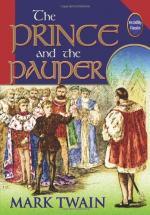{8} From ‘The English Rogue.’ London, 1665.
{9} Hume’s England.
{10} See Dr. J. Hammond Trumbull’s Blue Laws, True and False, p. 11.
Note 1, Chapter IV. Christ’s Hospital Costume.
It is most reasonable to regard the dress as copied from the costume of the citizens of London of that period, when long blue coats were the common habit of apprentices and serving-men, and yellow stockings were generally worn; the coat fits closely to the body, but has loose sleeves, and beneath is worn a sleeveless yellow under-coat; around the waist is a red leathern girdle; a clerical band around the neck, and a small flat black cap, about the size of a saucer, completes the costume.—Timbs’ Curiosities of London.
Note 2, Chapter IV.
It appears that Christ’s Hospital was not originally founded as a school; its object was to rescue children from the streets, to shelter, feed, clothe them.—Timbs’ Curiosities of London.
Note 3, Chapter V. The Duke of Norfolk’s Condemnation commanded.
The King was now approaching fast towards his end; and fearing lest Norfolk should escape him, he sent a message to the Commons, by which he desired them to hasten the Bill, on pretence that Norfolk enjoyed the dignity of Earl Marshal, and it was necessary to appoint another, who might officiate at the ensuing ceremony of installing his son Prince of Wales.—Hume’s History of England, vol. iii. p. 307.
Note 4, Chapter VII.
It was not till the end of this reign (Henry VIII.) that any salads, carrots, turnips, or other edible roots were produced in England. The little of these vegetables that was used was formerly imported from Holland and Flanders. Queen Catherine, when she wanted a salad, was obliged to despatch a messenger thither on purpose.—Hume’s History of England, vol. iii. p. 314.
Note 5, Chapter VIII. Attainder of Norfolk.
The House of Peers, without examining the prisoner, without trial or evidence, passed a Bill of Attainder against him and sent it down to the Commons . . . The obsequious Commons obeyed his (the King’s) directions; and the King, having affixed the Royal assent to the Bill by commissioners, issued orders for the execution of Norfolk on the morning of January 29 (the next day).—Hume’s History of England, vol iii. p 306.
Note 6, Chapter X. The Loving-cup.
The loving-cup, and the peculiar ceremonies observed in drinking from it, are older than English history. It is thought that both are Danish importations. As far back as knowledge goes, the loving-cup has always been drunk at English banquets. Tradition explains the ceremonies in this way. In the rude ancient times it was deemed a wise precaution to have both hands of both drinkers employed, lest while the pledger pledged his love and fidelity to the pledgee, the pledgee take that opportunity to slip a dirk into him!




